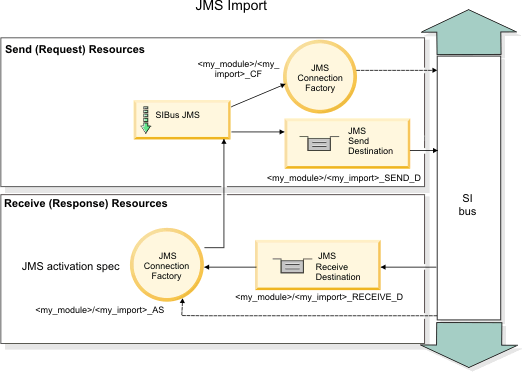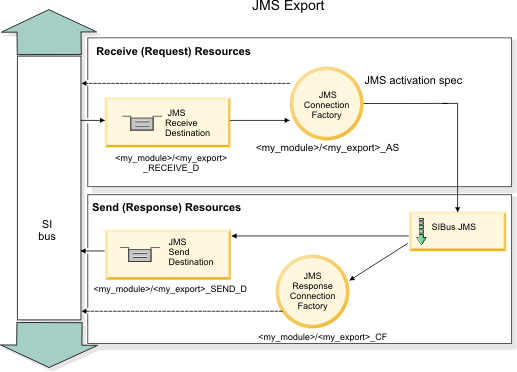IBM BPM, V8.0.1, All platforms > Get started with IBM BPM > Key concepts > Bindings > Binding types > JMS bindings
JMS import and export bindings
You can make SCA modules interact with services provided by external JMS applications using JMS import and export bindings.
JMS import bindings
Connections to the associated JMS provider of JMS destinations are created by using a JMS connection factory. Use connection factory administrative objects to manage JMS connection factories for the default messaging provider.
Interaction with external JMS systems includes the use of destinations for sending requests and receiving replies.
Two types of usage scenarios for the JMS import binding are supported, depending on the type of operation being invoked:
- One-way: The JMS import puts a message on the send destination configured in the import binding. Nothing is set in the replyTo field of the JMS header.
- Two-way (request-response): The JMS import puts a message on the send destination and then persists the reply it receives
from the SCA component.
The import binding can be configured (using the Response correlation scheme field in Integration Designer) to expect the response message correlation ID to have been copied from the request message ID (the default), or from the request message correlation ID. The import binding can also be configured to use a temporary dynamic response destination to correlate responses with requests. A temporary destination is created for each request and the import uses this destination to receive the response.
The receive destination is set in the replyTo header property of the outbound message. A message listener is deployed to listen on the receive destination, and when a reply is received, the message listener passes the reply back to the component.
For both one-way and two-way usage scenarios, dynamic and static header properties can be specified. Static properties can be set from the JMS import method binding. Some of these properties have special meanings to the SCA JMS runtime.
It is important to note that JMS is an asynchronous binding. If a calling component invokes a JMS import synchronously (for a two-way operation), the calling component is blocked until the response is returned by the JMS service.
Figure 1 illustrates how the import is linked to the external service.
Figure 1. JMS import binding resources
JMS export bindings
JMS export bindings provide the means for SCA modules to provide services to external JMS applications.
The connection that is part of a JMS export is a configurable activation specification.
A JMS export has send and receive destinations.
- The receive destination is where the incoming message for the target component should be placed.
- The send destination is where the reply will be sent, unless the incoming message has overridden this using the replyTo header property.
A message listener is deployed to listen to requests incoming to the receive destination specified in the export binding. The destination specified in the send field is used to send the reply to the inbound request if the invoked component provides a reply. The destination specified in the replyTo field of the incoming message overrides the destination specified in the send.
Figure 2 illustrates how the external requester is linked to the export.
Figure 2. JMS export binding resources